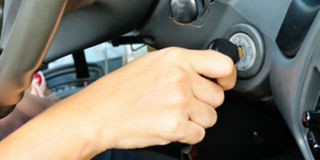Diagnosing ignition switch problems

The back and forth motion of inserting and removing the car key in the ignition cylinder means that the car key tumbler (the double rough edges of your car key) eventually become smooth or flat and lose the grip of interlocking into the key cylinder lock like a pulley system to start the engine. NET PHOTO
What you need to know:
- While there is no official service life for most ignition systems, you will typically end up replacing the ignition switch whenever it dies, which can happen suddenly. However, before replacing the switch, you need to do some troubleshooting.
Fidgeting to restart your car while in traffic jam can be a nightmare. Other motorists or onlookers might even think that you have run out of fuel and hoot at you to get out of the way.
The sudden stopping could be due to a faulty ignition switch. Normally, your car engine should start with a single turn of the key, assuming all factors such as sufficient fuel levels and a functional battery are kept constant. These are some of the issues that can help you understand that you have a bad ignition switch.
Car stalling
Car stalling is not specific to any vehicle brand. Eric Amadi, a mechanic at Dalas Auto in Bunga, Kampala, observes that one of the signs of ignition switch problems is when your car suddenly starts stalling. Stalling is when your engine comes to a complete stop.
You will succeed at forcefully restarting it by holding the key at the starting point of the ignition (this could break the key) but when you drive for a short distance, especially in traffic jam, the engine shuts down completely.
“For starters, you can mistake a stalled engine for a failing fuel pump. You might also call your mechanic thinking the car is not taking in fuel or it has a drained battery yet the problem is with the ignition switch,” Amadi explains.
Failure to display accessories
Car accessories include the radio, digital clock, air conditioner and the fuel trip metre embedded in the car clock, among others. If, for example, the fuel trip meter fails to turn on or the air conditioner fails to start, Amadi says the first thing to suspect is the ignition system.
“When these accessories fail to work, then it is time to have your ignition switch inspected by a motor vehicle electrician to correct the problem. If you start your car and it stalls immediately, it means the ignition switch is faulty,” Amadi adds.
Old or worn-out keys
Alvin Nkini differs from Amadi, saying everything else on your car, such as the car keys too wear out over time. This, he observes, is attributed to the frequency with which you insert and remove your car key in the ignition cylinder overtime. The ignition cylinder is one where you insert the car key before starting the car.
Therefore, this back and forth motion of inserting and removing the car key in the ignition cylinder means that the car key tumbler (the double rough edges of your car key) eventually become smooth or flat and lose the grip of interlocking into the key cylinder lock like a pulley system to start the engine. In some cases, the key will just slip through the ignition cylinder, creating car starting challenging for some vehicles. This, perhaps explains why you will find a commuter taxi driver starting his engine with a cupboard or tri-circle padlock key without any struggles.
Ignition switch faults
According to liveaboutdotcom, an online portal, the ignition switch itself is connected to the ignition cylinder by a shaft or lever. Inside the ignition switch, several contacts connect vital electrical systems needed to start and run the car.
Generally speaking, in the “off” position, the ignition switch does not connect anything; in the “Acc” position, the radio or fan may be energised; in the “run” position, the engine control module is energised; and finally, in the “Start” position, the starter relay is engaged. (These generalisations depend significantly on year, make, and model.)
“Worn ignition switch contacts, temperature problems, or broken springs can all cause the ignition switch to fail, preventing you from starting your car. On the road, poor ignition switch contacts could shut the engine off while driving, which could be dangerous,” the portal explains.
The portal advises that after ensuring the rest of the electrical system components such as fuses, relays, and circuits are intact, replace the ignition switch.
Key will not turn
Texas Premier Locksmith, also an online portal states that sometimes the key will not turn after you insert it into the ignition switch. In many cases, this is because your front wheels are turned, putting enough pressure on the steering linkage to bind the column lock and ignition switch. Try moving your steering wheel back and forth to loosen it up.
How to trouble shoot
•Open the fuse panel in your vehicle underneath the steering column.
•Remove the fuse for the ignition starter. Use the diagram on the underside of the fuse panel cover and the fuse puller located in the fuse box.
•Check the metal strip in the fuse. If it is broken or damaged in any way, replace the fuse with another fuse of the same amperage.
•Open the hood and set the dial on the voltmeter (an instrument for measuring electric potential in volts) to “Volts.”
•Touch the red lead on the voltmeter to the power terminal on the battery. Then, touch the black lead on the voltmeter to the negative terminal on the battery.
•Read the voltmeter display. The battery should give off 12.4 volts. If it does not, then the battery is dead. If the battery is good, then the problem may be with the ignition.



